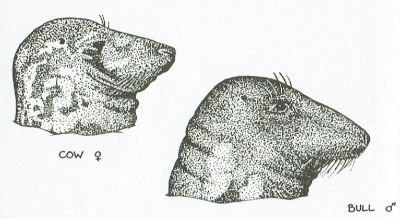Grey Seals
 The world population of around 280,000 Grey Seals Halichoerus grypus is confined to the North Atlantic and the Baltic Sea with a large proportion found within British waters. In general, number are increasing, althougn numbers in the Baltic, primarily in the Gulf of Finland) are in substantial declione. Preferring remote stretches of coastline, the majority of British Grey Seals occur along the western coast, particularly off the west coast of Scotland, but they can also be found on the east coast as far south as Lincolnshire.
The world population of around 280,000 Grey Seals Halichoerus grypus is confined to the North Atlantic and the Baltic Sea with a large proportion found within British waters. In general, number are increasing, althougn numbers in the Baltic, primarily in the Gulf of Finland) are in substantial declione. Preferring remote stretches of coastline, the majority of British Grey Seals occur along the western coast, particularly off the west coast of Scotland, but they can also be found on the east coast as far south as Lincolnshire.
Lundy is home to a breeding colony of around 60 Grey Seals, with up to double this number in the summer. They can be seen all around the island, particularly at their 'hauling-out' spots such as Seals's Rock, north of Gannet's Rock, Brazen Ward, Surf Point, Shutter Point and Rat Island. When out of the water they will lie on rocky ledges, ofter in groups, basking in the sunshine. However, they remain alert to danger and will heave themselves into the water if disturbed or threatened in any way. In the water, seals are often seen 'bottling' - staying upright with only their head showing above water. They can probably sleep in this position.
Recognition
 Bull Grey Seals are larger than cows with a distinct 'roman nose' profile to the head. Bulls also tend to be darker in colour, although both sexes have blotchy markings from black through shades of grey to brown and are lighter on their undersides. The patterns of blotches, particularly those on the upper body, may be used to identify individuals and studies using this technique have shown the same animals to be present around Lundy year after year. Adult bulls may grow to 3m (10ft) in length and weigh over 270kg (600lbs), but females typically measure around 1.8m (6ft). Male Grey Seals live for an average of 25 years and females for 35 years.
Bull Grey Seals are larger than cows with a distinct 'roman nose' profile to the head. Bulls also tend to be darker in colour, although both sexes have blotchy markings from black through shades of grey to brown and are lighter on their undersides. The patterns of blotches, particularly those on the upper body, may be used to identify individuals and studies using this technique have shown the same animals to be present around Lundy year after year. Adult bulls may grow to 3m (10ft) in length and weigh over 270kg (600lbs), but females typically measure around 1.8m (6ft). Male Grey Seals live for an average of 25 years and females for 35 years.
Breeding
Grey Seal pups are normally born with a white coat of fur in September or October, but are unable to swim immediately after birth so an undisturbed beach is usually chosen by the mother. On Lundy the intertidal sea caves, the far ends or which remain above the high water mark, are also used. At birth the pups are 85cm (3ft) long and weigh about 14kg (30lbs), but are vulnerable being washed off beaches by rough seas and to disturbance by humans. On a diet of high-fat milk they treble their weight over their first three weeks of life, and then moult into their darker coat and start to feed for themselves. First year survival has been estimatyed at around 50% and animals typically do not return to the breeding sites until 4 years of age.
For more information about seals around the coastline of South-west England or to report a seal in distress, please see the Cornwall Seal Group website.
Cetaceans and other seals
Common Dolphins Delphinus delphis can be seen from Lundy, usually between April and October usually in small groups of up to ten and occasionally in large pods of 100 or more. The larger, darker, Bottlenose Dolphin Tursiops truncatrus is much less common with only two or three records each year. Harbour Porpoises Phocoena phocoena are also seen regularly throughout the year, singly or in small groups.
Less commonly seen from the island or on the crossing are Risso's Dolphin Grampus griseus and Minke Whale Balaenoptera acutorostrata.
Common (Harbour) Seals Phoca vituilina are very uncommon in the waters around Lundy, but one was reported on four occasions in the summer of 2015.
